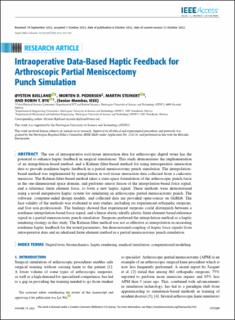| dc.contributor.author | Bjelland, Øystein | |
| dc.contributor.author | Pedersen, Morten Dinhoff | |
| dc.contributor.author | Steinert, Ralf Martin | |
| dc.contributor.author | Bye, Robin Trulssen | |
| dc.date.accessioned | 2023-01-27T06:43:54Z | |
| dc.date.available | 2023-01-27T06:43:54Z | |
| dc.date.created | 2022-10-17T09:35:25Z | |
| dc.date.issued | 2022 | |
| dc.identifier.citation | IEEE Access. 2022, 10 107269-107282. | en_US |
| dc.identifier.issn | 2169-3536 | |
| dc.identifier.uri | https://hdl.handle.net/11250/3046703 | |
| dc.description.abstract | The use of intraoperative tool-tissue interaction data for arthroscopic digital twins has the potential to enhance haptic feedback in surgical simulations. This study demonstrates the implementation of an interpolation-based method, and a Kalman filter-based method for using intraoperative interaction data to provide nonlinear haptic feedback in a partial meniscectomy punch simulation. The interpolation-based method was implemented by interpolation in tool-tissue interaction data collected from a cadaveric meniscus. The Kalman filter-based method takes a state-space formulation of the arthroscopic punch force in the one-dimensional space domain, and performs sensor fusion of the interpolation-based force signal, and a reference finite element force, to form a new haptic signal. These methods were demonstrated using a novel inexpensive haptic system for simulating an arthroscopic partial meniscectomy punch. The software, computer-aided design models, and collected data are provided open-source on GitHub. The face validity of the methods was evaluated in user studies, including six experienced orthopedic surgeons, and five non-professionals. The findings showed that experienced surgeons could distinguish between a nonlinear interpolation-based force signal, and a linear-elastic ideally-plastic finite element-based reference signal in a partial meniscectomy punch simulation. Surgeons preferred the interpolation method as a haptic rendering strategy in this study. The Kalman filter method was not as effective as interpolation in recreating nonlinear haptic feedback for the tested parameters, but demonstrated coupling of haptic force signals from intraoperative data and an idealized finite element method in a partial meniscectomy punch simulation. | en_US |
| dc.language.iso | eng | en_US |
| dc.publisher | IEEE | en_US |
| dc.rights | Navngivelse 4.0 Internasjonal | * |
| dc.rights.uri | http://creativecommons.org/licenses/by/4.0/deed.no | * |
| dc.title | Intraoperative Data-Based Haptic Feedback for Arthroscopic Partial Meniscectomy Punch Simulation | en_US |
| dc.title.alternative | Intraoperative Data-Based Haptic Feedback for Arthroscopic Partial Meniscectomy Punch Simulation | en_US |
| dc.type | Peer reviewed | en_US |
| dc.type | Journal article | en_US |
| dc.description.version | publishedVersion | en_US |
| dc.source.pagenumber | 107269-107282 | en_US |
| dc.source.volume | 10 | en_US |
| dc.source.journal | IEEE Access | en_US |
| dc.identifier.doi | 10.1109/ACCESS.2022.3212748 | |
| dc.identifier.cristin | 2061843 | |
| cristin.ispublished | true | |
| cristin.fulltext | postprint | |
| cristin.qualitycode | 1 | |

